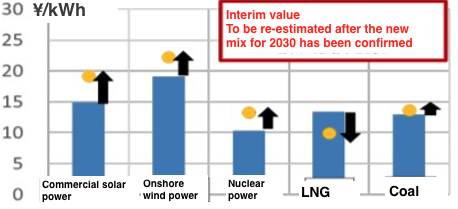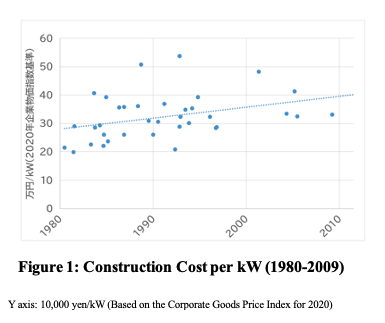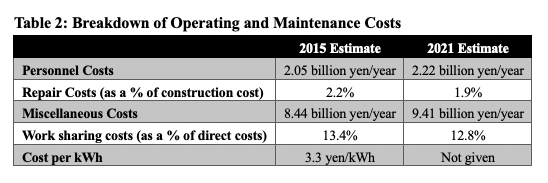Power Generation Cost Working Group Finally Comes up with New Estimate
By Matsukubo Hajime(CNIC)
On July 12, the Working Group on Verification of Power Generation Cost (hereafter, WG) of the Advisory Committee for Natural Resources and Energy, an advisory body to the Ministry of Economy, Trade and Industry, announced the outline of a new estimate of power generation cost. CNIC presented information on the costs of nuclear power generation at the 6th meeting of the WG (July 7). Here, I will explain the content of this new cost estimate and its limits.
- Outline of the new power generation cost estimate
First, let’s have a look at this new estimated cost of power generation. The cost of generating electricity per kWh is calculated by dividing the total cost of the new installation of a power source in 2030 by the total generated power, assuming it operates for a certain number of years (40 years for nuclear power plants) at a certain facility utilization rate (70% for nuclear power plants).
The most remarkable feature of this estimate is that the cost of generating electricity at nuclear power plants was not shown to be the cheapest for the first time ever in estimates made by Japanese government, including the Ministry of Economy, Trade and Industry (METI).
In estimates drawn up by METI thus far, whenever the cost of generating electricity at nuclear power plants seemed likely to be higher than that of other power sources, tricks such as altering the estimation method were used to make it look as if, on the basis of calculations, nuclear power came out looking cheaper. For example, in a power generation cost estimate carried out in 2011, CO2 countermeasure costs were included on the assumption that emissions trading, which has not yet been fully introduced in Japan, had been introduced. Further, in an estimate put together in 2015, nuclear power plants maintained their status as the cheapest power source due to a change in the calculation method for accident risk response costs and the soaring resource prices at that time. However, in the latest estimate, there has been little option but to accept the reality that nuclear power is no longer a cheap power source.
When power generation costs were estimated based on the WG calculations for 2015, LNG was the cheapest of the four power sources of oil, coal, LNG and nuclear power, followed by nuclear power, coal and oil. In this respect, the latest estimate was largely in line with expectations. In this new estimate, the cheapest power sources are commercial solar power from the low 8-yen level (more than 8 yen but less than 8.5 yen) to the high 11-yen level (more than 11.5 yen but less than 12 yen), followed by gas cogeneration from the high 9-yen level to the high 10-yen level, residential solar power from the high 9-yen level to the low 14-yen level, onshore wind power from the high 9-yen level to the low 17-yen level, medium-scale hydropower at the high 10-yen level, and nuclear power from the high 11-yen level upwards (see Table 1).
Given the above, some WG members put forward views such as the operating period of nuclear power plants should be set at 60 years, and the capacity utilization rate should be estimated at a higher level. This is because total generated power will increase if the number of years of operation and the capacity utilization rate are estimated at a higher level. In the case of nuclear power plants, with relatively low fuel costs, the increase in operating periods and capacity utilization rates does not significantly affect total costs. As a result, the power generation cost per kWh appears to fall.
At the 6th WG meeting, CNIC presented information showing that the average capacity utilization rate of nuclear power plants in Japan had exceeded 80% for only a few years, and that the overall average was 69% up to 2010, before the accident at Tokyo Electric Power Co.’s Fukushima Daiichi Nuclear Power Station. Even overseas, there were few countries where the capacity utilization rate was consistently above 80%. CNIC emphasized that the capacity utilization rate should be considered to be 70% at the most. In addition, regarding the number of years of operation of nuclear power plants, it was shown that the world’s oldest nuclear power plant in operation was the Swiss Betznau Nuclear Power Plant Unit 1, which has been in operation for 52 years. No nuclear power plant has been in operation for 60 years. Some nuclear power plants that had been scheduled to operate for 60 years were decommissioned before they reached the 60-year limit, and the average age of world nuclear power plants at decommissioning was 26.6 years.
In the end, while calculations were also performed using capacity utilization rates of nuclear power plants of 60% and 80%, and an operating period of 60 years, the basic scenario was maintained at 70% and 40 years.
- Problems of the new power generation cost estimate
This estimate can be given a favorable evaluation to some extent since it is the first time the government has admitted that nuclear power is not the cheapest power source. However, there are still many problems.
Capital costs
Based on the previous estimate, the capital cost of nuclear power plants was estimated to be 400,000 yen/kW (estimated in 2015 to be 370,000 yen/kW) based on data from the four nuclear power plants (sample plants) that started operation recently and adjusted for prices and other factors. However, it is doubtful that nuclear power plants can actually be built at this cost.
Members of the working group reported that, due to improvement and standardization of nuclear power plants, capital costs no longer fluctuate, but is that true? Construction cost per kW since 1980 is shown in Figure 1, which shows an upward trend.
Looking by reactor type, PWRs show little upward trend, while BWRs show an observable upward trend. There may be factors other than improvement and standardization. In Europe and the United States, construction costs have soared because structures have become more complex due to safety measures, the lengthening of construction periods, and other factors, but the same can also be said for Japan. The cost of complying with the new regulatory standards is estimated separately as additional safety measures, but this is calculated by subtracting the portion that would be unnecessary in the case of a new construction using the additional costs that have been incurred in existing nuclear power plants, but it is unclear whether this is a reasonable figure.
CNIC provided information to the WG to argue these points, but they were not adopted.
Operating and maintenance costs
Table 2 shows the estimated running and maintenance costs, also based on the sample plant data. Although the operation and maintenance cost per kWh is not stated in this estimate, it is expected to be roughly the same as in the previous estimate. Further, operation and maintenance costs are calculated based on the assumption that they are only required during the period of operation.
At the same time, electric power companies announce operating and maintenance costs for their nuclear power plants in their annual securities reports. Based on this, operating and maintenance costs do not change significantly before and after the decommissioning of nuclear reactors. In other words, maintenance costs are still being incurred even after reactors are decommissioned.
Since 30 to 40 years are required to decommission a nuclear power plant, this differs from other power sources. If these long-term costs are not taken into account, the cost of generating electricity from nuclear power plants would be estimated at an unreasonably cheap level.
CNIC provided information to the WG to argue these points, but again they were not adopted.
Integration costs
The “estimate of marginal cost reflecting system integration” was reported in the 5th WG meeting. In the report, cost estimates reflecting the integration of systems including nuclear power plants are reported (see Fig. 2). This is a calculation based on a certain model in which the cost to the entire power system when each power supply is increased by a certain amount is regarded as the “integration cost,” which is considered to be a cost incurred by the increased power supply.
It is shown that less flexible power supplies are cost-increasing factors, and the more flexible LNG is a cost-decreasing factor. What is interesting here is that nuclear power is also shown as a cost-increasing factor.
Fig. 2: Analysis and Estimate by Model Taking into Account Power Supply Siting and System Restrictions*

With the premise of the system restrictions in the power supply mix in 2030, the “integration cost” (costs of the decrease in thermal efficiency and use of pumped water, etc.) incurred over the entire power system in the case that each power supply is increased by a certain amount and the entire costs are considered to be incurred by the increased power supply.
Blue columns: Cost per kWh when a new power supply facility is constructed and operated on a vacant site
Yellow dots: Cost after imputing entire costs to the power supply in question
*Quoted from a member’s presentation materials at the 5th meeting of the Power Cost Verification WG
The price of electricity on the power market soared from December 2020 to January 2021. This factor was explained in detail in CNIC’s Japanese newsletter and in the Japanese language research report “Is the Prolonged Regular Inspection of Nuclear Power Plants the Cause of the Steep Rise in the Wholesale Electricity Market Price? The Hidden Risk of Huge Power Sources?” (cnic.jp/39079), and it is suspected that the price rise is causally related to prolonged regular inspections of nuclear power plants by Kansai Electric Power Co.
This is not the only time the suspension of nuclear power plants has been prolonged. For example, the Kashiwazaki-Kariwa plant was damaged by the Niigata Chuetsu-oki Earthquake in 2007. Three of the seven reactors have not operated since that time. In 2002, it was revealed that TEPCO had routinely falsified safety reports at its nuclear power plants. As a result, many nuclear power plants were forced to shut down, and a power crisis hit Tokyo Electric Power Co.’s service area in the summer of the following year. We still, of course, recall the rolling blackouts triggered by the power crisis caused by the suspension of nuclear power plants in the wake of the Great East Japan Earthquake.
Power output per nuclear power plant is too large to adjust. Backup power must also be available in the case of an outage. While instantaneous outages are serious, if the outage is prolonged, the impact will be huge. In addition, due to the inherent danger of nuclear power plants, problems found at one plant may spread horizontally, resulting in the shutdown of multiple nuclear power plants. In this case, the impact on the power system would be more severe.
Aside from the cost of integrating nuclear power plants, another concern is how to deal with cloudy or calm periods in renewable energy. Installing large numbers of new batteries would be extremely costly. However, if the batteries of electric vehicles, expected to increase in the future, can be utilized, the cost may be significantly reduced.
These costs are not taken into account in the new estimate, but will be estimated anew after the 2030 power supply mix is announced – something we need to keep an eye on.
- Comments
Members of the WG unanimously commented on the results of the trial calculation by saying, “Let’s not allow the figures to take on a life of their own,” meaning that numbers don’t tell you everything about a situation. However, the results of past WG estimates show that it is especially METI that has made use of the notion that nuclear power plants are the cheapest source of electric power. My feeling now is that being concerned about “not allowing the figures to take on a life of their own” is pretty meaningless at this stage of the game.
Despite the many problems, the results of the latest calculations have finally led Japan to recognize the standard international awareness that nuclear power plants and coal-fired thermal power plants are not as cheap as solar power, wind power, or LNG. This result will of course have a major impact on future energy policy.
It is also important to note that in addition to the cost of power generation by single facilities, integration costs have now been taken into account. This could possibly lead to moves to estimate the costs of variable power sources such as solar and wind power at a higher level.
In March 2021 Kansai Electric Power Co. and Chubu Electric Power Co. ended their contracts with the Shika NPS, even though they had regarded Shika as equivalent to their exclusively-owned power supply facility, on the pretext of expiration of contract. It appears that the structure that has maintained the nuclear village thus far is incapable of coping with the realities of power liberalization, the decline in electricity demand, and the inability of nuclear power plants to resume operations even after ten years.



